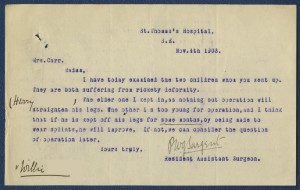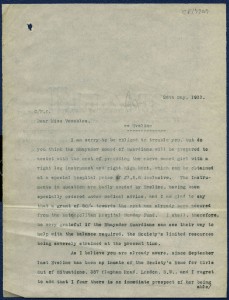Today, we have a guest post written by one of our project volunteers, David Lamb.
***
Earlier this month, the Royal College of Paediatrics and Child Health released guidance for healthcare staff on identifying the symptoms of rickets. This is in response to the rise in rickets, a condition common in Victorian times, but that had largely disappeared through the 20th century. Rickets is a bone-deforming disease caused by vitamin D deficiency, stunting growth and inhibiting walking.
Hospital admissions with rickets in England increased from 561 in 2008/09 to 702 last year. January and February are the worst months because of the low levels of UV light. Observations suggest a link with some children not playing outside. The issue was covered recently in the [London] Evening Standard (13.1.14).
Over 5% of the children who passed through The Children’s Society’s care between 1881 and 1917 had rickets recorded in their case files. Below are extracts from various cases to illustrate the situation in which rickets developed and a range of its impacts.
Three year old Lydia “lives in unhealthy street (in Hackney), and never goes out during the last three months I have known it. She sits with her feet under her, not attempting to walk, and seems to require nourishment and care. The room constantly is so close and smelly it is not conducive to the child’s health, and the mother is too deformed to do her own scrubbing. I think it one of the saddest cases I have ever known”.
The medical certificate for Annie aged six records rickets resulting in bowed legs and curvature of the spine, but “with proper care she is said to be curable”. Almost ten years on, boarded out in Suffolk, she is not considered “capable of carrying heavy weights or doing much hard work. … She takes great pleasure in, and does needlework nicely”.
With six year old Allan from Teesdale, rickets in both legs and wrists had left him “hopelessly crippled unless the deformity is corrected by operation”. The file does not record whether he had that operation. After seven years in Bradstock Lockett Home in Southport, he returned to his mother.
Some children did have their ‘rickety’ condition alleviated by surgery, as in this case below. (Like all the images in this blog, click on the image below to see a larger version.)
Others required special medical or ‘surgical’ appliances, for which funding had to be secured, as in this Welsh case:
Lily from Richmond, Surrey had genu valgum [knock knees] resulting from rickets when younger.
Another rickets case, Sarah, originally from Beverley, Yorkshire was “close upon 15 – but no bigger than a child of 8 – and thus quite debarred from domestic service as she is almost a dwarf”.
With Margaret from Oxfordshire, her rickets developed soon after birth deformities, such that as an eight year old she could not use her legs beyond standing a little. However, she could use her arms well and do needlework. At nearly 16, “she is deformed, height 4ft 3in – not a girl suitable for service – does housework very nicely but her height and limbs are very much against her. She has been through our laundry, but complains of her legs hurting her, after standing or walking far.”
Hopefully, raising the alert about rickets will avoid our generation of children any of the pain, discomfort and disabilities suffered in Victorian and Edwardian times.



Rickets
Dr Ayush Goel and Dr Frank Gaillard et al.
Rickets essentially refers to osteomalacia in the paediatric population that occurs prior to fusion of the growth plate.
Demographics and clinical presentation
Rickets is seen in a number of distinct populations which include 4:
premature infants (especially if on parenteral nutrition)
unbalanced infant nutrition
protracted exclusive breast feeding
non-vitamin D supplemented formula fed infants
vegetarian diets
maternal vitamin D deficiency
lack of sun exposure
dark skin in sun-poor countries
lack of out door time
clothing that eliminates sun exposure
The onset and presentation of rickets depends on the aetiology and degree of deficiency. Typically in severe cases rickets becomes apparent in the second year of life.
Presentation is usually with skeletal changes (see below) and bone pain.
Pathology
Results from abnormality or deficiency in one or more of 1:
1,25 di-hydroxy vitamin D
calcium
phosphorus
alkaline phosphatase
body pH
As a result of this imbalance the ratio of mineralised to non-mineralised osteoid is abnormal (with an excess of non-mineralised osteoid present) and bone strength is reduced.
Radiographic features
In the growing skeleton the deficiency of normal mineralisation is most evident at growth plates where there is an excess of non-mineralised osteoid resulting in growth plate widening. With increasing severity and abnormal biomechanics the metaphysis flares out and appears frayed.
It is not surprising that these features are most prominent at the growth plates where growth is greatest:
knee: distal femur, proximal tibia
wrist: especially the ulna 1
anterior rib ends: rachitic rosary
It is important to remember that even bones that appear mineralised are weak, and result in bowing, most commonly seen in the lower limbs once the child is walking. The legs bow outwards with variable deformity of the hips (both coxa vara and coxa valga are seen 1). The lower ribs may also be drawn inwards inferiorly by the attachment of the diaphragm (Harrison’s sulcus).
Treatment and prognosis
Treatment requires correction of the metabolic imbalance. Only rarely is orthopaedic surgical intervention required to correct skeletal deformities.
Differential diagnosis
The differential for leg bowing in children includes 2:
developmental or congenital bowing
Blount disease
osteogenesis imperfecta
many others that are not usually a consideration (see leg bowing in children).
The differential for widening of the growth plate includes:
scurvy
delayed maturation due to illness
endocrine disturbances
growth hormone excess
hyperparathyroidism
hypothyroidism
The differential for flaring of the metaphysis includes:
anaemia(s)
fibrous dysplasia
storage diseases
chronic lead poisoning
bone dysplasias
Dear Rahil,
Thanks for the link and the information!
Janine